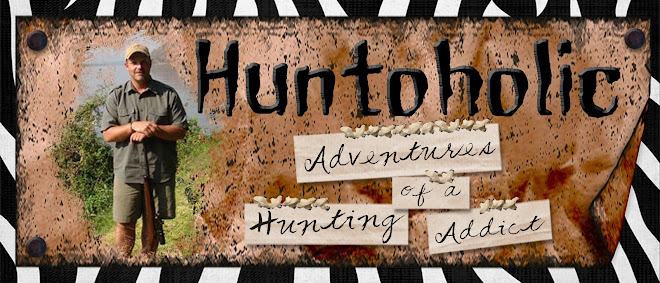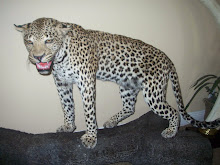 I LOVE to hunt buffalo. I was excited to be going into the Zambezi Valley in extreme northern Zimbabwe in June/July, 2008 because the numbers of buffalo in that area competes favorably with the other great buffalo areas in Africa. Though I intended to hunt many other species on this trip, including the aquatics (hippo and croc), I made it clear to my PH that I would be perfectly content in spending 75% of the trip trailing buffalo and ending up with a great bull.
I LOVE to hunt buffalo. I was excited to be going into the Zambezi Valley in extreme northern Zimbabwe in June/July, 2008 because the numbers of buffalo in that area competes favorably with the other great buffalo areas in Africa. Though I intended to hunt many other species on this trip, including the aquatics (hippo and croc), I made it clear to my PH that I would be perfectly content in spending 75% of the trip trailing buffalo and ending up with a great bull.Buffalo in most areas in southern Africa are hunted by driving back roads and looking for areas where herds of buffalo or smaller groups of "dugga boys" have crossed. The trackers then analyze how recently the bulls were on the road, and if it was any time in the last 5 hours, the group leaves the cruiser following the track through whatever terrain the herd transversed until, hopefully, the herd or dugga bulls are caught up to as they shade themselves from the noonday sun in the thick jess.
Working out a tough dugga bull track in the thick grass

 We were hunting the Dande North area, and there were plenty of buffalo. In fact, we'd seen groups of 2-3 dugga bulls which we couldn't get on, and huge herds of up to 250 animals. Several times we were close and either shots did not present themselves or we decided the trophy quality was not there. In the thick jess, it's possible to be within 20 yards of animals that can't be shot because of choke-thick brush. Once or twice we found ourselves, literally, in the middle of a herd and unable to move. We'd just sit and wait them out until they moved. But, without question, the most hair raising (if I had any) experience we had was getting in front of a herd that fed into us, forcing us to simply sit down in the open as dozens of animals fed around us on all sides. We were lucky that we avoided a charge from a cheeky cow.
We were hunting the Dande North area, and there were plenty of buffalo. In fact, we'd seen groups of 2-3 dugga bulls which we couldn't get on, and huge herds of up to 250 animals. Several times we were close and either shots did not present themselves or we decided the trophy quality was not there. In the thick jess, it's possible to be within 20 yards of animals that can't be shot because of choke-thick brush. Once or twice we found ourselves, literally, in the middle of a herd and unable to move. We'd just sit and wait them out until they moved. But, without question, the most hair raising (if I had any) experience we had was getting in front of a herd that fed into us, forcing us to simply sit down in the open as dozens of animals fed around us on all sides. We were lucky that we avoided a charge from a cheeky cow.Cows eyeballing us while we track
Spot the buff in the brush!


On the fourth day of the hunt, we cut the track of a big herd and left the cruiser at about 8:30 in the morning and spent the day playing cat and mouse with them. Throughout the day, the herd split up and was rejoined by a nice group of dugga boys giving the herd at least 4-5 bulls that I considered to be shooters.
In the late afternoon the trackers lost the track and it took us about an hour to sort it out. By the time they did, the sun was setting and it was just dumb luck that we stumbled into the herd in the THICK jess. We got to within about 50 yards and located portions of a very nice bull through the branches. Henry and I ducked behind a rock pile for cover and discussed the chances of getting a bullet through the thick stuff. While we were discussing we would occasionally poke our heads from around the rock to assess the situation with the bulls. Finally, I decided I could make the shot. I stepped out from behind and found the bottom of the horn curl as a reference on, what little I could see, of the bull's shoulder. The shot was absolutely perfect. The bull dove off the hill only about 100 yards and was piled up. When we walked over to where he had been standing when I shot, I could see him in the ravine below, and knew immediately it was not the bull we were targeting! Somehow, while we were discussing the shot, a younger bull had stepped in front of the bigger one. Both were standing in the same position, to the right and broadside with the head turned facing us.

Henry and I were SO depressed. The bull is not bad, but it's not what we had been hunting, and certainly was not any bigger than so many other bulls we'd turned down over the previous days.
Hanging meat out of hyena reach

To make matters worse, we were incredibly far from the cruiser. It was getting dark quick so we sent the guys back for the cruiser and some help in getting the meat out. Henry and I gathered some wood and sat in the pitch black (no moon) around a fire we had built in the bottom of a rock wash. When the guys returned with more men and no flashlight some three and a half hours later, we had reexamined the bull and decided he was not as bad as we had initially believed (still far from incredible). We built several fires around the bull and the guys went to work cleaning, skinning, caping and butchering the bull. Everything had to be carried out by the guys. Since there were only 10 porters, they stashed about half of the meat high up in several trees to keep it away from the hyenas, and went back in the morning for the rest of the meat. The natives waste NO part of any animal. They carried the prime meat, cape and horns out with us, but went back in the morning for EVERYTHING else.
Hauling the meat out in the dark


It was about 9:30 p.m. and PITCH BLACK when we started the 2 mile hike out to where the guys had left the cruiser. Again, no moon and no flashlight. I literally could not anything in front of me. The cruiser was somewhere above us on the ridge, but Henry and I had no idea where. For the first half mile or so, Fred, Henry's son, was walking behind me with his cell phone open and the dim light slightly illuminating about 5 feet around us; but the battery died soon and we were left to our own luck. The natives never took any missteps and never walked into anything. I, on the other hand, was continually walking into thorn bushes and stepping in holes. It was a miserable hour and a half walk. I've never been so grateful to see a vehicle than I was when the first trackers got to the truck and turned the lights on. It was about 1:30 am by the time we had driven all the way back to the Pedza camp. 

Incidentally, about a mile out from the Pedza camp we came upon a very nice male leopard walking right down the middle of the road. Seeing one of these cats like that is extremely unusual, and we believe it's the same cat Kory ended up shooting off a bait on about day 13 of the hunt.
















1 comment:
Whoa! I'd have been scared out of my wits! I'm also clumsy enough to have ended up needing to be hauled up into a tree and left there until morning. (You know, I think I'd kinda like to go to Zim. for our mission.)
Post a Comment